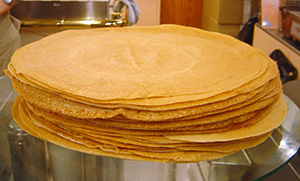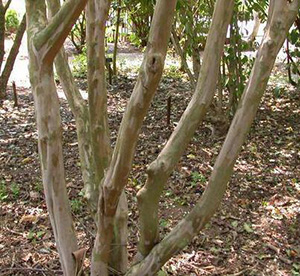You Sure This is a Crepe Myrtle?
You Sure This is a Crepe Myrtle?
Site Ecology Team, W.A.I.T., Bill Willis and John McLamb
September 11, 2014

Employees using the main entrance off T.W. Alexander have noticed that five of the twelve crape myrtles (CM) that lined that access point have been pruned to their base. As a result of pruning, sprouts have begun to grow from the base of the stumps. This regeneration below the cut is common when deciduous trees are cut down. You may have also noticed similar phenomena around Discovery Lake where beavers have cut down maples and sweet gum near the water. The trees there have also generated trunk and basal sprouts following beaver “cut and drag”. Whereas the lake trees are mainly sprouting from a single trunk, the crape myrtles are known for sprouting along their roots, and sometimes the trunk. Other familiar species that have root sprouts include plum, crabapple, and Bradford pear. We are not dealing with beavers at the main gate for there are no tooth marks, wood chips, or drag lines. In response to an employee’s question about the health of the crape myrtles, we wanted to find out more about the situation and future plans.
Mr. Steve Johnson-Grounds Contractor; Brian Harris-Project Officer; Jeff Taylor-Consulting Horticulturalist for NIEHS and other folks familiar with our grounds helped explain the evolution of events. The current crape myrtles were planted in August 1988, but they weren’t the first planting for that median area; 365 Junipers were put in the middle strip initially. In 1988 the crape myrtles were inter-planted with the junipers in two parallel rows of six trees each. When grass or mulch replaced the junipers, the CM became the main feature at the entrance. The CM are now at least 32 years old and have lived beyond their prime mature age and height. Under “ideal conditions” crape myrtles could live 30+ years depending on the genetic variety and environmental stresses. Even though our trees were in full sun, well spaced, mulched, fertilized bi-annually, disease and pest free, and allowed to grow naturally as 3-5 stem specimens, they were under stress that we couldn’t see. It is believed that the soil was too moist and subsequently a failed root system became the weak link which contributed to their decline.
A plant’s root system must be extensive enough to support new growth, flowering, and seed set and, likewise, the crown sufficient to nourish the roots. There’s a shoot-to-root balance that is maintained in healthy trees. If a stress such as poorly drained soil causes root rot during periods of excessive rains, then the roots can’t do root things. Last year’s cold and wet winter had a serious effect on our trees and revealed CM sensitivity to cold conditions.
In the spring of 2014 when several CM trees didn’t leaf out and appeared dead, they were severely pruned to within two feet of the ground in order to see if they would rejuvenate. Within weeks, all grew shoots from their bases. Two of the trees, cut earlier in the winter, had shoots that were mature enough to flower. Jeff’s plan for NIEHS is to reassess tree health next spring to see if all the trees leaf out (pruned and not pruned). If they do leaf out, then all the trees not already pruned will be pruned back to match the other pruned ones. He says that the second step will be to remove all but one strong shoot and train it into a single stemmed tree. Hopefully in a couple years and a little luck, these shoots will develop into small trees with good limb structure capable of supporting numerous flowers. Should the before mentioned effort not be successful, then consideration will be given to replacing these trees with the same or another species.
Facts about Crape Myrtles

Crape myrtles (Lagerstroemia indica) are small deciduous trees or large shrubs (less than 30 feet) that have gained popularity with homeowners and landscapers. Many public properties as well as medians and urban streets are lined with these plants. Even though widely used in the South, they aren’t a native species. They are distinctive in that they offer interesting characteristics in all seasons, such as colorful multi-stems, fall foliage color, large summer flower clusters, wide variety of colors, and interesting seedpods. Since the time our trees were planted, there has been much attention given to hybridization and cultivar development thus creating a large selection of colors and sizes.
These plants do well all across North Carolina, except at high elevations. They are tolerant to a wide range of soil types, even piedmont clay, and are not heavy feeders. They do however require well-draining acidic soils and experience chlorosis (yellowing) under alkaline conditions. Seed babies are not a problem and this exotic doesn’t become invasive, maybe overused.
Crape myrtles should be planted in an area where they can reach their full potential and do not require a lot of pruning to fit their allotted space. If a plant this size is not suitable for your location, there are varieties that are slow growing (dwarf) that might be used. Removing crossed branches is beneficial and desirable. Whereas multiple stems are common, the plant can be established early as a single main stem (tree). Severe stem “topping” pruning very seldom produces a natural looking plant, rather a large lollypop. Since flowers develop on the new growth in the spring, branches that radiate from near the cut, will usually be long and weak with a tendency to droop and conceivably break.
According to the NCSU Cooperative Extension Service, severe pruning each year to 5-6 feet or less will never allow the plant to again look natural, but just create a cycle of yearly cutbacks. Cutting back to less than 12 inches from the ground creates a rounded, shrub-like plant like we are seeing near the front entrance. This form of rejuvenation seldom produces as good a specimen as the original tree. If there was a contributing problem underground, it’d still be there. After evaluating the situation, your best approach may be is to remove the tree entirely, amend the soil, and replant with other cultivars or a new species.
How to prune: Please see How Do I Prune Crape Myrtle? and Pruning a Crape Myrtle for information about pruning Crape Myrtles.
By far the most often seen pest is the Crape myrtle aphid with accompanying sooty mold fungus and visitation by ants and bees. Heavy aphid infestations will cause leaf yellowing and possible leaf curling, not to mention the blackened leaves. If natural control of aphids (lacewing, lady beetles, parasitic wasp) isn’t sufficient, it may be necessary to resort to chemical treatment. Be sure that beneficial insects are absent before resorting to the use of chemicals.
*Both Crepe and Crape terms are used interchangeably, as two words with Myrtle or as one word.
A special thanks to the individuals mentioned in this article for sharing their knowledge.
References



